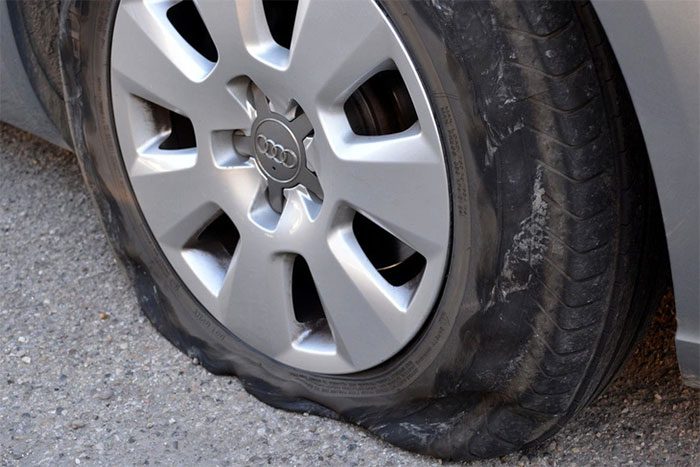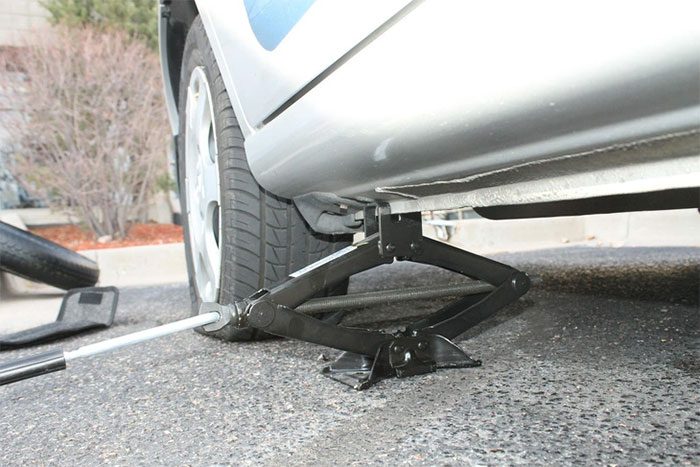In many countries, car tires can withstand temperatures ranging from below zero to over 100°C; however, the safe threshold is no more than 90°C.
According to initial assessments, the high temperature of the road surface and the lack of rest stops lead to continuous driving, which increases pressure on the tires and causes incidents.
Multiple Causes of Tire Blowouts

A tire exploded while in motion – (Photo: GETTY IMAGES).
A team of automotive engine researchers from the University of Technology Sydney (Australia) states that the temperature of the road surface is closely related to the functioning of car tires.
Typically, warmer tires provide better traction; however, excessively high temperatures can damage tires and increase wear.
According to the research team, the ideal temperature for tire operation is between 20-30oC. This is the “ideal” range, while the actual operational temperature range can be quite broad, from below zero to over 100oC.
This means that it is very difficult for tires to blow out solely due to temperature. Evidence shows that some desert roads in Australia have surface temperatures around 50-70oC but remain safe for tires.
In addition to external temperature, there are many other causes. For instance, driving at higher speeds generates more heat. Heavy loads also increase the pressure and temperature of the tires. Uneven, bumpy roads can generate additional heat due to increased friction, according to Zac Morris, an automotive engine expert in the United States.
Tire quality also has a significant impact. The U.S. Department of Transportation has established a Uniform Tire Quality Grading (UTQG) system that classifies tires into categories. Category A tires can dissipate heat effectively when vehicles travel over 185 km/h, category B from 160-185 km/h, and category C from 136-160 km/h.
However, despite the many factors mentioned above, Zac Morris believes that when tire temperature exceeds 90oC, drivers must exercise caution and consider their driving. Above this level, the risk of damage increases significantly.

Regularly check tire pressure and tread depth before driving – (Photo: GETTY IMAGES).
Inflate Tires Adequately and to the Correct Pressure
Osuagwu Solomon, an automotive mechanical engineer in the U.S., suggests that to limit the tire temperature from rising too high, drivers should pay attention to some relatively simple guidelines.
First is the tire pressure. Under-inflated tires are more prone to overheating. At this time, the tire’s contact area with the road is larger, creating more friction and heat.
Similarly, overloading will exert additional pressure on the tires, increasing the risk of overheating and blowouts.
Additionally, regular tire maintenance is advisable. Older tires should avoid driving on rough, potholed roads, especially during the summer heat. If possible, monitor tire temperature using infrared thermometers or tire thermometers.
Automotive writer Krista Doyle (U.S.) also recommends that drivers should frequently check tire pressure. She explains that the air inside the tire expands when the temperature rises, increasing internal pressure. Currently, most passenger vehicle tires operate at around 30-35 PSI.
Conversely, low tire pressure poses risks while driving as it increases the contact area of the tires with the road beyond necessary levels, thus increasing friction. High friction generates high tire temperatures, increasing the risk of blowouts or detachment from the rim.
She believes that tires should be inflated to the appropriate pressure, providing necessary traction with the road, maintaining stability, supporting effective braking, and minimizing fuel consumption. Additionally, maintaining proper tire pressure helps reduce uneven tire wear, extending tire lifespan.
Recommendations from Various Countries
In Dubai (United Arab Emirates), where outdoor temperatures in summer are consistently high, the Roads and Transport Authority (RTA) advises that when the outdoor temperature reaches 50°C, drivers must check their tires to ensure they meet regulatory standards.
Specifically, vehicles with tires older than 5 years from the date of manufacture are prohibited from road use. Tires must be replaced if there are signs of wear, cracks or cuts in the sidewall, damaged tread strips, or if the tread depth is less than 1.6mm in any part of the tread.
In Dubai, driving with inappropriate tires can result in a 500 Dh fine (about 4 million VND), 4 demerit points on the driver’s license, and potential vehicle impoundment for a week. Statistics indicate that about 5% of traffic fatalities in the UAE are due to tire-related accidents.
Meanwhile, the Australian Traffic Management Association recommends that drivers should have an automatic tire pressure monitoring device (PSI). On hot days, the PSI may temporarily increase. When the PSI rises too high, tires may blow out.
The commonly recommended formula is that for every 10°C increase in tire temperature, tire pressure may increase by 1-2 PSI. Meanwhile, the recommended PSI typically falls within the range of 30-35 PSI. When the gauge indicates a Psi level significantly above this range, drivers are advised to stop their vehicles.


















































